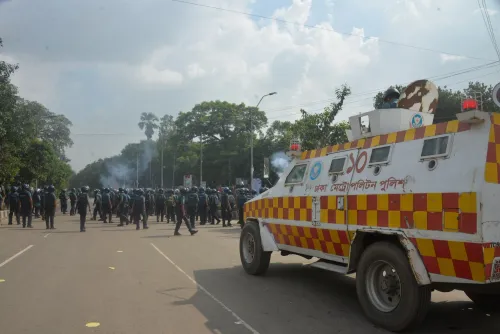Could a US-Pakistan Campaign to Retake Bagram Spark a Wider War?

Synopsis
Key Takeaways
- US military presence at Bagram could destabilize South Asia.
- Collaboration with Pakistan raises questions about Islamabad's autonomy.
- Humanitarian crises may result from renewed military actions.
- Taliban's response indicates fear of increased US pressure.
- Pakistan's internal challenges complicate its role in Afghanistan.
Dhaka: The United States appears ready to re-engage in the very region it once left behind: Bagram. What Washington terms a tactical adjustment could swiftly evolve into a strategic upheaval for South Asia. A renewed US initiative - reportedly in collaboration with Pakistan's security forces - to reclaim Bagram Air Base and establish a presence in Afghanistan poses a risk of igniting a larger regional conflict, reinvigorating refugee flows, enhancing jihadist networks, and pulling Pakistan deeper into a security quagmire. The pressing question is not if the dust will settle, but how many nations, communities, and lives will be caught in the fallout.
US President Donald Trump has framed this as a correction of the “missteps” of the previous administration, indicating a resurgence of US interest in re-establishing a footprint at Afghanistan’s strategic Bagram Air Base. Washington's outreach has already prompted Islamabad to prepare for potential operations that may involve seizing Bagram and altering the current Taliban-led regime. Reports suggest that should such a military campaign proceed, US-Pakistani forces might target specific areas within Afghanistan, focusing on militant groups threatening Pakistan, including the Tehreek-e-Taliban Pakistan (TTP).
The Afghan Taliban has reportedly responded to these developments by instructing their Defence Ministry and the so-called Tath'heri (Purification) Commission to purge biometric records of Taliban officials and fighters - a move characterized in reports from the Middle East Research Institute (MEMRI). This directive is said to reflect profound anxiety among Taliban leaders that renewed US pressure or the collapse of negotiations at Bagram could provoke unilateral attacks or renewed efforts to dismantle their command structures.
Erasing biometric data is both a practical and symbolic gesture. Practically, the destruction of fingerprints, iris scans, and other identifiers complicates external tracking of commanders and fighters; it makes it easier for militants to cross borders, assume new identities, or seek refuge in other networks. Symbolically, this purge signals a loss of confidence in negotiations and a preparation for the worst-case scenario: renewed military pressure that could once again transform Afghanistan into a hub for transnational militancy. Human rights and humanitarian organizations have long cautioned against the dangers posed by biometric systems in Afghanistan — both when those systems fall into insurgent hands and when their erasure removes accountability for vulnerable civilians.
Intelligence reports suggest militants are preparing multiple fallback strategies: some may attempt to integrate with groups like Al Qaeda and the Islamic State Khorasan Province (ISKP); others may cross into Pakistan’s tribal districts and border provinces. Such movements, if they occur en masse, would recreate the destabilizing dynamics Islamabad faced post-2001 - namely, the influx of fighters, weaponry, and illicit finances into Pakistan’s frontier regions, with substantial costs in lives, displacement, and security.
There are already indications of high-stakes diplomacy and renewed security engagements between Washington and Islamabad. Recent interactions among US and Pakistani military and political leaders suggest a rapid re-engagement that some analysts interpret as a strategic gamble by Pakistan’s military to regain influence and secure economic or security concessions from Washington. However, whether Islamabad will accept a subordinate role in a US-led operation in Afghanistan remains uncertain; domestic politics, sectarian divides, and a range of ongoing internal insurgencies complicate any Pakistani commitment.
Pakistan’s domestic climate renders any external venture riskier. The Pakistani Army is currently grappling with military operations in Balochistan and Khyber Pakhtunkhwa; concurrently, significant political unrest in Pakistan-occupied Kashmir (PoK) and increasing opposition activities within the country would make reallocating troops and resources to a new Afghan campaign politically costly and operationally challenging. Additionally, the persistent threat posed by TTP and other domestic militant groups means Islamabad cannot simply redeploy its security forces without leaving critical vulnerabilities at home. In essence, the calculus that once made Pakistan a willing partner for extraterritorial operations has transformed. The Pakistan of the 2000s is not the same as the Pakistan of today.
If Washington and Islamabad proceed with coordinated offensives to reclaim Bagram and penetrate into Afghanistan, the immediate human toll will be severe. Large-scale operations — including airstrikes, special-forces raids, and cross-border pursuits — will almost certainly lead to significant civilian casualties, internal displacement, and the disintegration of fragile local governance structures. The reintroduction of sustained foreign military activity would also provoke reactions from regional powers. Iranian and Russian officials have repeatedly cautioned that aggressive US maneuvers in Afghanistan could escalate into broader confrontations, while China has expressed concerns about renewed American military presences in Central and South Asia.
A renewed campaign might also ignite competition over Afghanistan's illicit economies, particularly the opium trade. Historically, control over narcotics routes and processing has financed militias and threatened to entangle security services in corrupt practices. If Pakistan’s Inter-Service Intelligence (ISI) and other entities become further involved in attempts to manage smuggling routes or extract rents from the trade, this will exacerbate domestic corruption and undermine the legitimacy of state institutions.
Finally, the political ramifications within Pakistan could be significant. Opposition parties and civil society could mobilize against what they view as another perilous foreign entanglement, while marginalized groups in troubled provinces might exploit the diversion to intensify insurgencies. The combination of military overstretch, economic strain, and a renewed influx of fighters into the tribal belt would render Pakistan considerably less stable — and thus less capable of managing the very threats a joint operation claims to address.
In summary, the potential for a US-Pakistan operation to reclaim Bagram is not merely a tactical issue concerning bases and battalions. It is a decision with extensive geopolitical, humanitarian, and domestic repercussions: for Afghan civilians, for Pakistan's fragile political landscape, and for the broader regional equilibrium.
Reoccupying Bagram would be a Pyrrhic victory. Even if US and Pakistani forces temporarily seize territory, the underlying strategic issues that have long plagued Afghanistan - fractured governance, opportunistic militancy, narcotics economies, and the absence of a legitimate, inclusive political settlement - will persist. Worse, a military-first approach risks exporting instability into Pakistan and throughout the region.
If there is any hope for stabilizing Afghanistan, it must rely on clear political objectives, robust humanitarian protections, and a regional framework that encompasses not only the United States and Pakistan but also Afghanistan’s neighboring countries.
Policymakers in Washington and Islamabad should prioritize caution over bravado: the lives lost, institutions shattered, and refugee crises triggered by yet another foreign intervention cannot be rectified by a mere airstrike or a series of proclamations.
(The writer is an award-winning journalist and Editor of Dhaka-based media outlet Blitz. He specializes in counterterrorism and regional geopolitics. The views expressed are personal)









